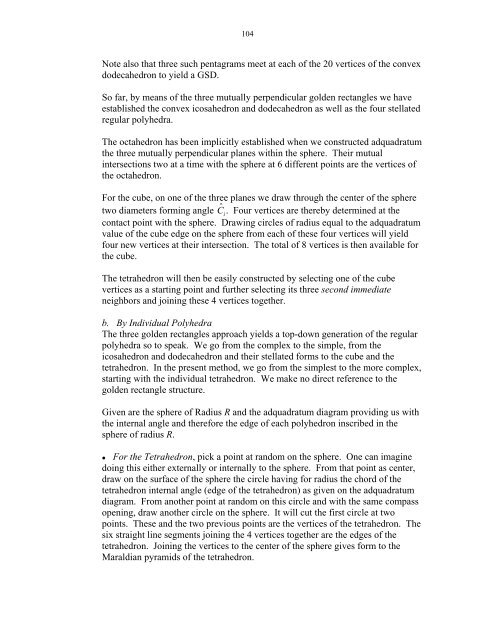Ad Quadratum Construction and Study of the Regular Polyhedra
Ad Quadratum Construction and Study of the Regular Polyhedra
Ad Quadratum Construction and Study of the Regular Polyhedra
Create successful ePaper yourself
Turn your PDF publications into a flip-book with our unique Google optimized e-Paper software.
104<br />
Note also that three such pentagrams meet at each <strong>of</strong> <strong>the</strong> 20 vertices <strong>of</strong> <strong>the</strong> convex<br />
dodecahedron to yield a GSD.<br />
So far, by means <strong>of</strong> <strong>the</strong> three mutually perpendicular golden rectangles we have<br />
established <strong>the</strong> convex icosahedron <strong>and</strong> dodecahedron as well as <strong>the</strong> four stellated<br />
regular polyhedra.<br />
The octahedron has been implicitly established when we constructed adquadratum<br />
<strong>the</strong> three mutually perpendicular planes within <strong>the</strong> sphere. Their mutual<br />
intersections two at a time with <strong>the</strong> sphere at 6 different points are <strong>the</strong> vertices <strong>of</strong><br />
<strong>the</strong> octahedron.<br />
For <strong>the</strong> cube, on one <strong>of</strong> <strong>the</strong> three planes we draw through <strong>the</strong> center <strong>of</strong> <strong>the</strong> sphere<br />
two diameters forming angle C ˆ<br />
i.<br />
Four vertices are <strong>the</strong>reby determined at <strong>the</strong><br />
contact point with <strong>the</strong> sphere. Drawing circles <strong>of</strong> radius equal to <strong>the</strong> adquadratum<br />
value <strong>of</strong> <strong>the</strong> cube edge on <strong>the</strong> sphere from each <strong>of</strong> <strong>the</strong>se four vertices will yield<br />
four new vertices at <strong>the</strong>ir intersection. The total <strong>of</strong> 8 vertices is <strong>the</strong>n available for<br />
<strong>the</strong> cube.<br />
The tetrahedron will <strong>the</strong>n be easily constructed by selecting one <strong>of</strong> <strong>the</strong> cube<br />
vertices as a starting point <strong>and</strong> fur<strong>the</strong>r selecting its three second immediate<br />
neighbors <strong>and</strong> joining <strong>the</strong>se 4 vertices toge<strong>the</strong>r.<br />
b. By Individual <strong>Polyhedra</strong><br />
The three golden rectangles approach yields a top-down generation <strong>of</strong> <strong>the</strong> regular<br />
polyhedra so to speak. We go from <strong>the</strong> complex to <strong>the</strong> simple, from <strong>the</strong><br />
icosahedron <strong>and</strong> dodecahedron <strong>and</strong> <strong>the</strong>ir stellated forms to <strong>the</strong> cube <strong>and</strong> <strong>the</strong><br />
tetrahedron. In <strong>the</strong> present method, we go from <strong>the</strong> simplest to <strong>the</strong> more complex,<br />
starting with <strong>the</strong> individual tetrahedron. We make no direct reference to <strong>the</strong><br />
golden rectangle structure.<br />
Given are <strong>the</strong> sphere <strong>of</strong> Radius R <strong>and</strong> <strong>the</strong> adquadratum diagram providing us with<br />
<strong>the</strong> internal angle <strong>and</strong> <strong>the</strong>refore <strong>the</strong> edge <strong>of</strong> each polyhedron inscribed in <strong>the</strong><br />
sphere <strong>of</strong> radius R.<br />
For <strong>the</strong> Tetrahedron, pick a point at r<strong>and</strong>om on <strong>the</strong> sphere. One can imagine<br />
doing this ei<strong>the</strong>r externally or internally to <strong>the</strong> sphere. From that point as center,<br />
draw on <strong>the</strong> surface <strong>of</strong> <strong>the</strong> sphere <strong>the</strong> circle having for radius <strong>the</strong> chord <strong>of</strong> <strong>the</strong><br />
tetrahedron internal angle (edge <strong>of</strong> <strong>the</strong> tetrahedron) as given on <strong>the</strong> adquadratum<br />
diagram. From ano<strong>the</strong>r point at r<strong>and</strong>om on this circle <strong>and</strong> with <strong>the</strong> same compass<br />
opening, draw ano<strong>the</strong>r circle on <strong>the</strong> sphere. It will cut <strong>the</strong> first circle at two<br />
points. These <strong>and</strong> <strong>the</strong> two previous points are <strong>the</strong> vertices <strong>of</strong> <strong>the</strong> tetrahedron. The<br />
six straight line segments joining <strong>the</strong> 4 vertices toge<strong>the</strong>r are <strong>the</strong> edges <strong>of</strong> <strong>the</strong><br />
tetrahedron. Joining <strong>the</strong> vertices to <strong>the</strong> center <strong>of</strong> <strong>the</strong> sphere gives form to <strong>the</strong><br />
Maraldian pyramids <strong>of</strong> <strong>the</strong> tetrahedron.




